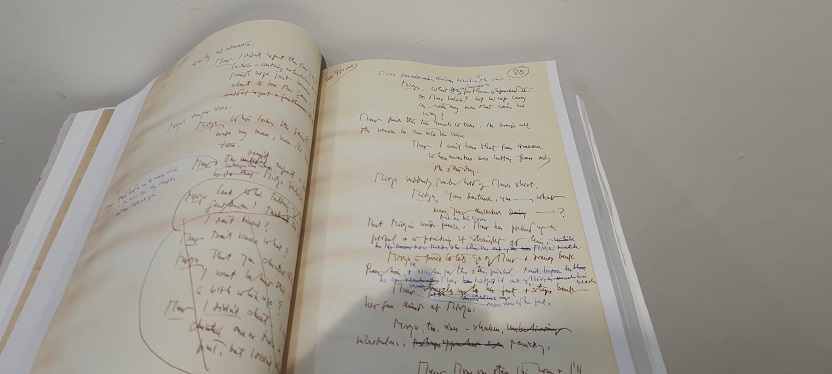Opening at the Kamladevi Hall on 23 October is an exhibition titled, ‘A King’s Gambit’ which is of Satyajit Ray’s spectacular costumes of his film, ‘Shatranj Ke Khilari’.
The pandemic has been a long nightmare with extended pain to millions who have been displaced and locked out of their work and livelihood. Naturally all cultural activity came to a halt but the India International Centre has announced its annual festival after a gap of almost two years.
Opening at the Kamladevi Hall on 23rd October is an exhibition titled, ‘A King’s Gambit’ which is of Satyajit Ray’s spectacular costumes of his film, ‘Shatranj Ke Khilari’. The film in Hindi was produced in 1977 by Suresh Jindal who has generously loaned the costumes for the exhibition. The film is based on Premchand’s story by the same name. The chess game between
There are many working stills and rich insights into Ray at work. Suresh Jindal writes, he had the curiosity and inquisitiveness of a child and a visit to his home found Ray surrounded with books piled high on the food, clothing and mannerism of the time. Ray states he got a great deal of information about the period from a book, ‘Lucknow, the Last Phase of Eastern Culture’ translated into English from the original Urdu.

A preview of the exhibition showed much more for the lover of Ray’s work, there is Satyajit’s kheror khata – cloth bound notebooks with minute details of the genius at work: his ideas, research notes, doodles, pen portraits, titles of books and even lists of possible actors and actresses. These have been digitized by the National Digital Library at Kolkata which has done invaluable work in restoring India’s heritage before it is lost forever! Ray was a prolific letter writer and wrote frequently to his team in Bengali, but here we have his letters to his producer, Suresh Jindal all in English, framed for posterity in his elegant signature style. Bansi Chandragupta scoured the city for authentic props and finally found some in Calcutta but the heirlooms were generously loaned by Wajid Ali Shah’s great grandson, Anjam Qadir. Through working stills and accompanied notes we learn that Sanjeev Kumar was never at ease on a shoot but relaxed after a few days and that his co-actor Saeed Jaffrey felt ‘he was a very shy human being but there is a precious talent in him which one respects.’
Then there are insights as to how the two dozen British officers needed for the takeover were obtained. Jindal wrote to the High Commissions and Embassies offering a weekend in Jaipur if they wanted to act as officers! Ray’s biographer, Marie Seton, tells us that they went in a bus with four tailors and a load of equipment. She reveals that everyone was treated to a sumptuous banquet except for Ray and the unit with tailors who had to slave in the hotel basement. What you get is but a glimmer of the arduous, painstaking even painful preparations before the final call of ‘Silence!’ ‘Roll!’ ‘Action!’ for a film is finally a director’s medium.
The costumes with their varied brocades, fabric, colour, texture and design are spectacular as are the gararas and shararas, the head gear and the nawab’s ‘taj’ (crown). One sees the amazing and close collaboration that Ray had with so many people and the intricate rendering of an era replete with hookahs, bolsters, handis and sherwanis.
The film and its production show-cases our syncretic cultures and the celebration of our diversity. However, one wonders if such a seamless production is even possible now with the recent controversy over Fabindia’s Diwali advertisement using the words, ‘Jashn – e Riwaaz’. Right wing activists and the BJP Yuva Morcha President, Tejaswi Surya said Deepavali is not Jashn – e- riwaaz and that depicting models without traditional Hindu attires must be called out. He asked for a boycott of the brand. In view of the controversy generated by the rightwing activists, Fabindia regrettably pulled off the advertisement.
The exhibition is symbolic of an era when people of different faiths collaborated but the only article of faith was the creation of a work of art that would last the test of time and be celebrated on the world stage of cinema.
Along with ‘A King’s Gambit’ will be a screening of Ray’s classic films, ‘Charulata,’ Aranyer Din Ratri, ‘Sonar Kella’ and others. One can only savour Satyajit Ray – enjoy the Jashn – e – riwaaz for the exhibition lasts till 5th of November – imbibe his finesse and cinematic genius and fervently hope we return to a more tolerant and mutually celebratory time.
Sagari Chhabra is an award-winning author & film-maker. She is director of the ‘HamaaraItihaas’ archives.

